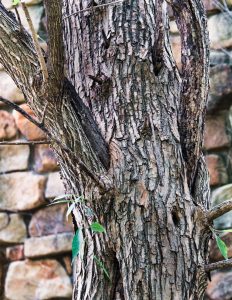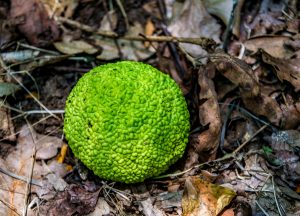As you walk the trails at River Legacy, you probably have already noticed large orange-looking fruits on the ground. They are typically green in color.
These fruits belong to the Osage orange tree (Maclura pomifera). It is a relatively small tree (reaching about 30 to 50 feet tall) that is native to this area of the state. Despite its appearance and name, this plant is not related to oranges at all. In fact, it is a member of the mulberry family, the Moraceae. It is named after the Osage Native American tribe of Missouri.
Nowadays, it has been spread by people to 39 states in the United States and parts of Canada but its natural range only included the Red River drainage in Oklahoma, Texas, and Arkansas. River Legacy sits right in the heart of this tree’s natural range. There is evidence that in prehistoric times, its range included a much larger area in the central part of the North American continent. In fact, some scientists have proposed that it once relied on megafauna animals that lived hundreds of thousands of years ago such as giant ground sloths (genus Megatherium) and perhaps even Columbian mammoths (Mammuthus columbi) to disperse its seeds. The large animals would eat the fruits and disperse the seeds via their droppings.
Next time you take a walk at River Legacy and see Osage oranges on the ground or squirrels feeding on them, just think to what the park might have looked many hundreds of thousands of years ago with giant ground sloths and/or mammoths feasting on them. In fact, fall is a great time to come and see Osage oranges on the ground. As you walk from the parking lot to the inside of River Legacy Living Science Center, there are a couple of Osage orange trees that you can appreciate!


